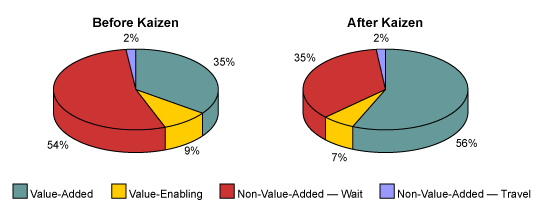
Many in the healthcare industry, as well as other industries, think that new technology – automated systems and expensive equipment – can assure vastly improved workflow. In reality, too often new technology is infused into old processes, therefore greatly reducing the benefits of the investment. That was the initial experience at Virtua Voorhees Histology Lab in New Jersey, USA. However, Virtua decided to address workflow issues that continued after new equipment was installed by employing a Lean toolset, particularly Kaizen events.
For decades, overnight tissue processing was the only alternative for histology labs. Same-day results were not an option due to the limits of technology. Today’s technology has changed the landscape in the histology lab and offers drastically faster processing time. The microwave technology that formerly took 12 hours to process can now process in just one hour.
Taking Advantage of Technology
Virtua wanted to take advantage of technological advances and purchased a new machine for the histology lab in order to provide same-day biopsy results and, in turn, better patient care. After the new microwave processor had been installed and the staff trained, the lab did not see the drastic reduction in turnaround time that management had expected. The machine was processing fast, but the workflow bottlenecks that had been present prior to the microwave installation had not been addressed. The process steps surrounding the microwave continued to operate on a 12-hour cycle. The histology staff struggled with the lack of progress and found that process changes were difficult to implement given the current lab layout and uneven processing times for each step.
Virtua leaders decided to use Lean to address the problem. Plenty of opportunity existed. The expected turnaround time was being exceeded by almost five hours. Lean leaders set goals to reduce biopsy cycle time, reduce machine idle time, and reduce non-value-added tissue wait time.
Following the Lean philosophy of understanding the process before diving into problem-solving, Kaizen leaders had their team of dedicated lab technicians and external participants observe the process. The team observed that the tissue did not move smoothly from station to station. The different stations were in multiple rooms in the lab, increasing travel time and making it very difficult to establish visual management. “Walking the flow” helped the team realize that many variables needed to be considered in order to fully integrate the new technology. Regulating specimen transport, cost-effective staffing, a healthy environment for technicians, layout barriers, transcription workflow and case distribution to pathologists were just a few of the areas that needed to be tackled.
The process map in Figure 1 shows what the team observed – non-value-added wait time between every process step. Multiple hand-offs and lack of visibility were contributing to increased cycle time.

In the histology lab, the team set out to relocate equipment and change the configuration of the lab stations to accommodate a smooth transition between process steps. The plan was to reduce or eliminate wait times between process steps. This proved to be a difficult task. Space constraints, cost and employee safety (exposure to fumes) were critical factors. After multiple trystorming attempts, the team created a circular layout. The updated layout opened up the flow and placed required pieces of equipment close to each other.
The changes meant lab technicians would end one process step at the same spot where they started the next process step. A major driver of bottlenecks in the histology process could be attributed to machine run time, particularly pertaining to the microwave, stainer and cover slip machine. In order to keep the process moving forward, the team emphasized keeping the machines constantly running with the implementation of audible and visual signals. The cues help operators know when the machine has completed processing and ensures that the machines were constantly being loaded when capacity exists.
Streamining the Processes
Following the tissue processing, the team also wanted to streamline the pathology and transcription processes. In order to avoid cases piling up on the pathologist’s desks, logic was written into the laboratory information system to automatically distribute the workload evenly among the team. The logic created a consistent flow of cases to the pathologists. In transcription, it was difficult to see when new reports needed to be transcribed. The team relocated the transcribing station and moved the drop-off location for completed tapes to make the process visible and greatly reduce wait times.
As the process changes were implemented, the team started to see the benefits to the workflow of the new technology. The cases were evenly distributed throughout the day, wait times were being reduced or eliminated, and the tissue samples started to move quickly through the process. Additionally, the machines were always loaded, and the machine idle time was significantly reduced. Virtua was starting to see the benefits of their investment.
By addressing the workflow issues, the Kaizen team was able to reduce non-value-added wait time was by 57 minutes per case. Figure 2 shows increase in percentage of value-added in process.

At the end of the Kaizen event, the team successfully reduced the biopsy cycle time by 3½ hours, nearly a 50 percent reduction. More important than the numbers was the impact on the patient. The new technology and accompanying Kaizen workflow changes allow patients to find out their biopsy test results the same day as their procedure. This kind of excellent service is not provided by many histology labs in the United States, and it is the kind of initiative on which Virtua prides itself.